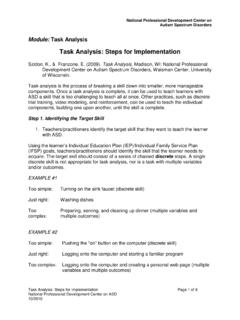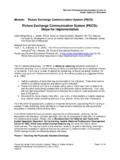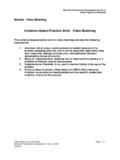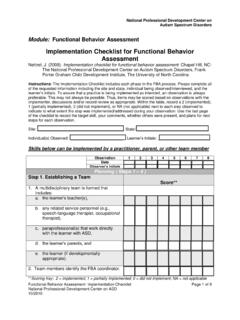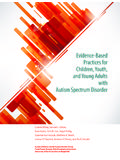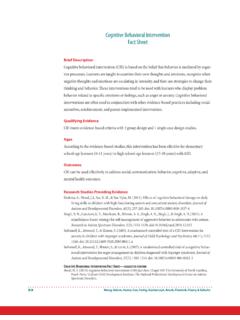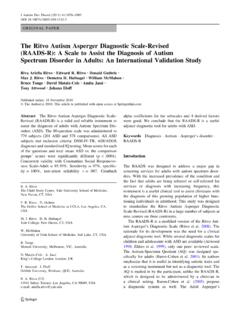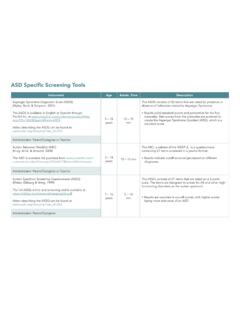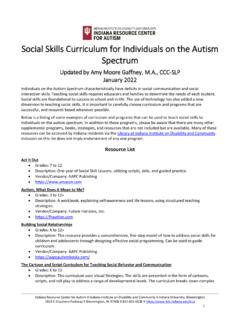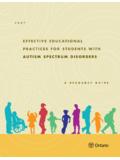Transcription of Functional Behavior Assessment - Autism PDC
1 National Professional Development Center on Autism Spectrum Disorders Module: Functional Behavior Assessment (FBA) Functional Behavior Assessment : Cover Sheet Page 1 of 1 National Professional Development Center on ASD 10/2010 Evidence-Based Practice Brief: Functional Behavior Assessment (FBA) This evidence-based practice brief on FBA includes the following components: 1. Overview, which gives a quick summary of salient features of the practice, including what it is, who it can be used with, what skills it has been used with, settings for instruction, and additional literature documenting its use in practice 2. Steps for Implementation, detailing how to implement the practice in a practitioner-friendly, step-by-step process 3. Implementation Checklist, to be used to monitor fidelity of the use of the practice 4. Evidence Base Summary, which details the NPDC-ASD criteria for inclusion as an evidence-based practice and the specific studies that meet the criteria for this practice National Professional Development Center on Autism Spectrum Disorders Module: Functional Behavior Assessment (FBA) Functional Behavior Assessment : Overview Page 1 of 3 National Professional Development Center on ASD 10/2010 Overview of Functional Behavior Assessment Collet-Klingenberg, L.
2 (2008). Overview of Functional Behavior Assessment . Madison, WI: The National Professional Development Center on Autism Spectrum Disorders, Waisman Center, The University of Wisconsin. Functional Behavior Assessment (FBA) is a systematic set of strategies that is used to determine the underlying function or purpose of a Behavior , so that an effective intervention plan can be developed. FBA consists of describing the interfering or problem Behavior , identifying antecedent or consequent events that control the Behavior , developing a hypothesis of the Behavior , and testing the hypothesis. Data collection is an important part of the FBA process. Often, teachers/practitioners use Functional communication training (FCT), differential reinforcement, response interruption/redirection, extinction, and stimulus control/environmental modification to address these behaviors in learners with ASD. Evidence FBA meets evidence-based criteria with five single-subject and one group design studies across ages, as well as in the domains of Behavior and communication.
3 With what ages is FBA effective? According to the evidence-based studies, learners with ASD ranged in age from 3 to 15 years with the majority of studies showing the effectiveness of Functional Behavior Assessment with elementary age learners. What skills or intervention goals can be addressed by FBA? FBA targets skills in the domains of Behavior and communication, usually with a focus of decreasing inappropriate Behavior and teaching or increasing appropriate communicative alternatives. The studies in the evidence base targeted behaviors described as severe, stereotypical, disruptive, escape-motivated, rejecting, and leading. Replacement skills included more appropriate forms of communication such as signing, pointing, talking, and the use of alternative and augmentative communication (AAC) devices. In what settings can FBA be effectively used? In the evidence base, Functional Behavior Assessment procedures were implemented in a variety of home, school, and community settings.
4 Evidence Base The studies cited in this section document that this practice meets the NPDC on ASD s criteria for an evidence-based practice. This list is not exhaustive; other quality studies may exist that were not included. National Professional Development Center on Autism Spectrum Disorders Module: Functional Behavior Assessment (FBA) Functional Behavior Assessment : Overview Page 2 of 3 National Professional Development Center on ASD 10/2010 Preschool Mancil, , Conroy, , Nakao, T., & Alter, (2006). Functional communication training in the natural environment: A pilot investigation with a young child with Autism spectrum disorder. Education and Treatment of Children, 29(4), 615-633. Elementary Buckley, S., & Newchok, D. (2005). Differential impact of response effort within a response chain on use of mands in a student with Autism . Research in Developmental Disabilities, 26(1), 77-85. LaBelle, C., & Charlop-Christy, M.
5 (2002). Individualizing Functional analysis to assess multiple and changing functions of severe Behavior problems in children with Autism . Journal of Positive Behavior Interventions, 4(4), 231-241. Lucyshyn J. M., Albin, R. W., Horner, R. H., Mann, J. C., Mann, J. A., & Wadsworth, G. (2007). Family implementation of positive Behavior support for a child with Autism : Longitudinal, single-case, experimental, and descriptive replication and extension. Journal of Positive Behavior Interventions, 9(3), 131-150. Middle/High School Butler, L. R., & Luiselli, J. K. (2007). Escape-maintained problem Behavior in a child with Autism : Antecedent Functional analysis and intervention evaluation of non-contingent escape and instructional fading. Journal of Positive Behavior Interventions, 9(4), 195-202. Selected Additional References Asmus, J. M., Franzese, J. C., Conroy, M. A., & Dozier, C. L. (2003). Clarifying Functional analysis outcomes for disruptive behaviors by controlling consequence delivery for stereotypy.
6 School Psychology Review, 32(4), 624-630. Aspy, R., & Grossman, B. G. (2007). The ziggurat model. Shawnee Mission, KS: Autism asperger Publishing Company. Bregman, J. D., Zager, D., & Gerdtz, J. (2005). Behavioral interventions. In F. R. Volkmar, R. Paul, A. Klin, & D. Cohen (Eds.), Handbook of Autism and pervasive developmental disorder, 3rd ed. (pp. 897-924). Hoboken, NJ: John Wiley & Sons. Carr, E. G., Horner, R. H., Turnbull, A. P., Marquis, J. G., McLaughlin, D. M., McAtee, M. L., et al., (1999). Positive Behavior support for people with developmental disabilities: A research synthesis. Washington, DC: American Association on Mental Retardation. National Professional Development Center on Autism Spectrum Disorders Module: Functional Behavior Assessment (FBA) Functional Behavior Assessment : Overview Page 3 of 3 National Professional Development Center on ASD 10/2010 Drasgow, E., Halle, J. W., Ostrosky, M. M., & Harbers, H.
7 M. (1996). Using Behavior indication and Functional communication training to establish an initial sign repertoire with a young child with severe disabilities. Topics in Early Childhood Special Education, 16, 500-521. Fox, L., Dunlap, G., & Buschbacher, P. (2000). Understanding and intervening with children s interfering Behavior : A comprehensive approach. In A. M. Wetherby & B. M. Prizant (Eds.), Autism spectrum disorders: A transactional developmental perspective, Volume 9 (pp. 307-332). Baltimore: Brookes Publishing Company. Henry, S., & Myles, B. S. (2007). The comprehensive Autism planning system (CAPS) for individuals with asperger s syndrome, Autism , and related disabilities: Integrating best practices throughout the student s day. Shawnee Mission, KS: Autism asperger Publishing Company. Koegel, L. K., Stiebel, D., & Koegel, R. L. (1998). Reducing aggression in children with Autism toward infant or toddler siblings. The Journal of Association for Persons with Severe Handicaps, 23(2), 111-118.
8 Martin, C. A., Drasgow, E., Halle, J. W., & Brucker, J. M. (2005). Teaching a child with Autism and severe language delays to reject: Direct and indirect effects of Functional communication training. Educational Psychology, 25(2&3), 287-304. National Technical Assistance Center on Positive Behavioral Interventions and Supports. O Neill, R. E., & Sweetland-Baker, M. (2001). Brief report: An Assessment of stimulus generalization and contingency effects in Functional communication training with two students with Autism . Journal of Autism and Developmental Disorders, 31(2), 235-240. National Professional Development Center on Autism Spectrum Disorders Module: Functional Behavior Assessment (FBA) Functional Behavior Assessment : Evidence Base Page 1 of 2 National Professional Development Center on ASD 10/2010 Evidence Base for Functional Behavior Assessment The National Professional Development Center on ASD has adopted the following definition of evidence-based practices.
9 To be considered an evidence-based practice for individuals with ASD, efficacy must be established through peer-reviewed research in scientific journals using: randomized or quasi-experimental design studies. Two high quality experimental or quasi-experimental group design studies, single-subject design studies. Three different investigators or research groups must have conducted five high quality single subject design studies, or combination of evidence. One high quality randomized or quasi-experimental group design study and three high quality single subject design studies conducted by at least three different investigators or research groups (across the group and single subject design studies). High quality randomized or quasi experimental design studies do not have critical design flaws that create confounds to the studies, and design features allow readers/consumers to rule out competing hypotheses for study findings. High quality in single subject design studies is reflected by a) the absence of critical design flaws that create confounds and b) the demonstration of experimental control at least three times in each study.
10 This definition and criteria are based on the following sources: Horner, R., Carr, E., Halle, J., McGee, G., Odom, S., & Wolery, M. (2005). The use of single subject research to identify evidence-based practice in special education. Exceptional Children, 71, 165-180. Nathan, P., & Gorman, J. M. (2002). A guide to treatments that work. NY: Oxford University Press. Odom, S. L., Brantlinger, E., Gersten, R., Horner, R. D., Thompson, B., & Harris, K. (2004). Quality indicators for research in special education and guidelines for evidence-based practices: Executive summary. Arlington, VA: Council for Exceptional Children Division for Research. Rogers, S. J., & Vismara, L. A. (2008). Evidence-based comprehensive treatments for early Autism . Journal of Clinical Child and Adolescent Psychology, 37(1), 8-38. National Professional Development Center on Autism Spectrum Disorders Module: Functional Behavior Assessment (FBA) Functional Behavior Assessment : Evidence Base Page 2 of 2 National Professional Development Center on ASD 10/2010 Using these criteria, the empirical studies referenced below provide documentation for supporting Functional Behavior Assessment as an evidence-based practice for children with ASD.
